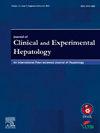控制衰减参数作为评估活体肝供者肝脂肪变性的工具的评价
IF 3.3
Q2 GASTROENTEROLOGY & HEPATOLOGY
Journal of Clinical and Experimental Hepatology
Pub Date : 2025-02-12
DOI:10.1016/j.jceh.2025.102514
引用次数: 0
摘要
背景目前,活体肝脏捐献者术前肝脏脂肪变性(HS)的检测缺乏标准化方案。肝脏脂肪变性会危及受体的预后,带来多种潜在并发症。振动控制瞬态弹性成像(Fibroscan®)提供了一个受控衰减参数(CAP),我们在评估活体肝脏捐献者的肝脏脂肪变性时采用了该参数。方法在2022年10月至2024年7月期间,我们对67名肝脏捐献者进行了术前振动控制瞬态弹性成像(Fibroscan®)和术前或术中肝脏活检。HS的定义是脂肪含量超过10%。CAP读数与肝活检结果并列,以诊断HS。根据本机构的规程,捐献者被分为三类:HS 含量为 5% 的捐献者、HS 含量为 5-10% 的捐献者、HS 含量为 10% 的捐献者。结果CAP检测HS非常准确,接收者操作特征曲线下面积为0.99(P <0.05)。统计分析表明,CAP 临界值为 266 dB/m 时,预测 HS 的灵敏度为 100%,特异度为 98.4%。相应的阳性预测值 (PPV) 为 85.71%,阴性预测值为 100%。单变量分析表明,体重指数(BMI)、年龄和血清甘油三酯水平与 CAP 相关;但多变量线性回归显示,只有体重指数(P <0.001)和年龄(P <0.002)与 CAP 相关。结论CAP作为活体肝脏捐献者肝脏脂肪变性(HS)的预测工具具有很大的潜力。值得注意的是,体重指数和年龄已被确定为与 CAP 值相关的独立因素。本文章由计算机程序翻译,如有差异,请以英文原文为准。

Evaluation of Controlled Attenuation Parameter as a Tool for Assessment of Hepatic Steatosis in Living Liver Donors
Background
Currently, there is an absence of a standardised protocol for the preoperative detection of hepatic steatosis (HS) in living liver donors. A steatotic liver graft jeopardises the outcome of the recipient with multiple potential complications. Vibration-controlled transient elastography (Fibroscan®) provides a controlled attenuation parameter (CAP), which we have utilised in our assessment of HS in living liver donors. This approach offers a promising avenue for the advancement of preoperative evaluation protocols.
Methods
In the period spanning from October 2022 to July 2024, a cohort of 67 liver donors were subjected to preoperative vibration-controlled transient elastography (Fibroscan®) and either preoperative or intraoperative liver biopsy. HS was defined as a fat content exceeding 10%. CAP readings were juxtaposed with liver biopsy results for the diagnosis of HS. Donors were categorised into three categories with HS <5%, 5–10% and those with HS >10% were rejected as per our institutional protocol. This facilitated a comprehensive evaluation of HS in the context of living donor liver transplantation.
Results
CAP was very accurate in detecting HS, with an area under the receiver operating characteristic curve of 0.99 (P < 0.05). Statistical analysis determined that a CAP cutoff value of 266 dB/m provides a sensitivity of 100% and a specificity of 98.4% for predicting HS >10%. Corresponding positive predictive value (PPV) is 85.71%, while the negative predictive value is 100%. Univariate analysis determined body mass index (BMI), age and serum triglyceride levels were associated with CAP; however, multivariate linear regression revealed an association with only BMI (P < 0.001) and age (P < 0.002). When a lower fat threshold of 5% was considered to define HS with the same cut off of CAP, the sensitivity reduced to 66.7% and specificity was 98.3% The recipients of donors with HS of 5%–10% did not show any negative outcomes.
Conclusion
CAP demonstrates significant potential as a predictive tool for hepatic steatosis (HS) in living liver donors. Notably, BMI and age have been identified as independent factors associated with CAP values.
求助全文
通过发布文献求助,成功后即可免费获取论文全文。
去求助
来源期刊

Journal of Clinical and Experimental Hepatology
GASTROENTEROLOGY & HEPATOLOGY-
CiteScore
4.90
自引率
16.70%
发文量
537
审稿时长
64 days
 求助内容:
求助内容: 应助结果提醒方式:
应助结果提醒方式:


